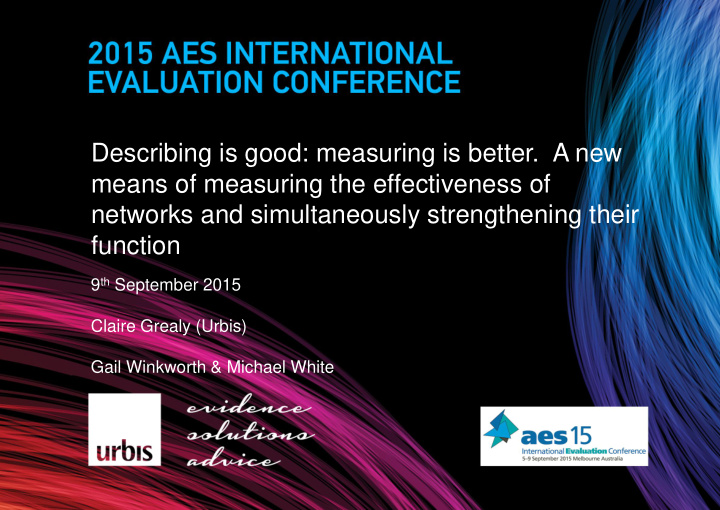



Describing is good: measuring is better. A new means of measuring the effectiveness of networks and simultaneously strengthening their function 9 th September 2015 Claire Grealy (Urbis) Gail Winkworth & Michael White
Known dimensions of collaborative effort Incentives to collaborate Willingness to collaborate Ability to collaborate Capacity to collaborate Grass roots engagement and planning Solid structures to support engagement The right people Appropriate resourcing Inclusiveness
Known dimensions of collaborative effort Differences in Power Differences in Professional Values, Ethics and Priorities Differences in Agency Commitment Differences in Agency Priorities and Planning Mechanisms Time and Other Resources
Three “Must Have” Drivers Should do…( is there a shared understanding of its public value?) Public Value Authority May do…( is there an authorising environment?) Capability Can do…( is there operational capacity to implement?)
Successful Collaborations The Rubric Matrix Building Partnerships that Work COMMUNICATE CO-ORDINATE COLLABORATE CREATE CAPACITY 1. SHARED PRACTICE 2. RESPONDING TO COMMON CLIENTS The Rubric describes 3. JOINT PROFESSSIONAL the 18 factors which DEVELOPMENT 4. DEDICATED RESOURCES build effective 5. JOINT BUDGET MANAGEMENT partnerships - and it does this for each of AUTHORITY the 4 different types of collaboration. 6. LEGISLATION AND POLICY 7. TENDERING SYSTEM In this way agencies 8. LEADERSHIP 9. HISTORY can build more 10. ORGANISATIONAL complex types of COHERENCE 11. EXTERNAL SUPPORT collaboration using the 12. STAKEHOLDER SUPPORT 72 descriptors which 13. SERVICE USER SUPPORT make up the roadmap SHARED VALUE of reform 14. VISION AND PHILOSOPHY 15. GOAL SETTING 16. PLANNING FOR SHARED GOALS 17. GOVERNANCE 18. DATA COLLECTION
Successful Collaborations Four Types of Collaboration Building Partnerships that Work Create to Increasing complexity f partnership accomplish social change Increasing complexity of needs Collaborate to address service gaps Coordinate to increase service accessibility Communicate to better understand client issues and build trust
The Action Learning Cycle ASK Using the survey to gather information on the partnership ANALYSE BUILD Identifying the Acting on strengths and specific challenges of the recommendation partnership s from the Rubric REFLECT Identifying the ways in which change can happen
ACT Total of All Networks 2014 Capacity to Partner 74% Summary: Average across the available items 63% 89% Staff knowledge of services (C1) 78% 88% Staff communication skills (C2) 86% Resource Sharing (C4) 79% 86% Staff contact measures (C3) 80% 76% Shared Practice Framework (C11) 62% 75% Resolving Service Gaps (C10) 50% 73% Information sharing practices - 2nd measure (C6) 66% 73% Span of partnerships 2nd measure (C13) Positive 2014 63% Positive 2013 73% Staff Development (C7) 63% 72% Improving service accessibility (C8) 65% 67% Key program connections (C9) 67% Span of partnerships 66% Information Practices (C12) 55% 64% Budget management (C15) 43% 56% Network Co-ordination (C5) 0% 10% 20% 30% 40% 50% 60% 70% 80% 90% 100%
ACT Total of All Networks 2014 Authority to Partner 72% Summary 65% 92% Middle Managers role (A3) 90% Staff commitment (A6) 88% 85% Informal staff networks(A7) 79% 79% Senior Executives leadership 3rd measure (A4) 75% 78% Policy support (A1) 72% 75% Senior executive leadership 2nd measure (A2) 73% 75% Client views (A13) 53% Positive 2014 Positive 2013 74% Focussed professional development (A12) 57% 68% Collaboration History (A8) 63% 67% Funders support (A14) 69% 62% Conflicts resolution (A9) 60% Senior leadership (A5) 55% 51% Agencies independence (A11) 49% 45% Boards support (A10) 46% 0% 20% 40% 60% 80% 100%
ACT Total of All Networks 2014 Shared Value 55% Summary: Average across available items 40% 53% Right partners (SV8) 51% Governance group(SV7) 36% 51% Documented governancea arrangements (SV6) 42% 40% Share data (SV5) Positive 2014 30% Positive 2013 55% Measuring outcomes (SV4) 44% 63% Planning (SV3) 63% Related strategies (SV2) 63% Purpose statements (SV1) 46% 0% 10% 20% 30% 40% 50% 60% 70%
Strategies to improve partnerships Develop shared practice knowledge – common set of guiding principles, language, practice • models, tools, case reviews, shared professional development Continue to build relationships – staff at all levels meet, exchange information, build trust • Improve accessibility of services and address service gaps through more sophisticated forms • of collaboration Strengthen key roles - Network Coordinators / team and other operational leaders • Strengthen role of governance group at the local level – shared statement of purpose, shared • goals, extend local partnerships beyond program focus Increase accountability for participation in governance meetings •
Measured change Create to accomplish social change Collaborate to address service gaps 2014 ACT is here Coordinate to increase service accessibility 2013 ACT was here Communicate to better understand client issues and build trust
ACT Overall 2013 65% 40% Authority Shared Value 64% Capacity
ACT Overall Change 2013-2014 75% 50% Authority Shared Value 73% Capacity
Reflections Good process underpins a successful change to a genuinely collaborative model A structured process that allows for honest reflection on “how we are going” Network ownership of the process is critical.
Details Dr Gail Winkworth gail.winkworth@acu.edu.au Michael White successfulcollaborations.com.au Michael@mwgroup.net.au Claire Grealy cgrealy@urbis.com.au
Recommend
More recommend